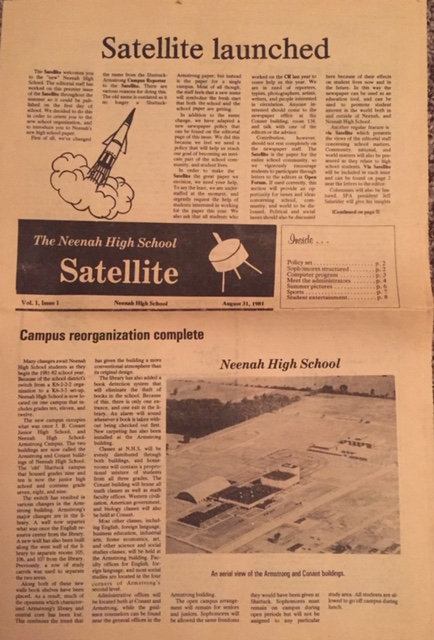Neenah Satellite Promotes Student Voices Since 1981
Originally a printed paper, the Satellite has covered a wide variety of articles, columns, cartoons and more since it was introduced
October 11, 2018
Homecoming reminds the community of the school spirit held by both past and present generations, and the evolving school newspaper has been there every step of the way to document NHS history.
Today’s history lesson features the evolution of NHS’s scholastic press.
NHS has had several student newspapers. The earliest one, first published in 1923, was called the Cub.
The Cub served as NHS’s main student paper until 1972, when the high school was divided between the Shattuck and Armstrong campuses. This resulted in the forming of two separate newspapers: the Campus Reporter and the Coleslaw.
Publication of the Coleslaw ended in 1977, making the Campus Reporter the paper for both buildings.
The birth of the Satellite, NHS’s current student newspaper, did not take place until 1981. The first edition was published after the Armstrong and Conant campuses were reorganized to house the 10th, 11th and 12th grades.
Originally a printed paper, the Satellite has covered a wide variety of articles, columns, cartoons and more since it was introduced. Today’s modern online format debuted in the year 2000, making NHS’s student paper more environmentally friendly and accessible for students.
A newspaper cannot be made possible without the staff. Today, the Satellite is advised by journalism teacher Mrs. Beth Plankey, who took the position in 1993. The Satellite is unique for being solely online, Plankey shares.
In the Satellite’s first edition, one article by the staff explained the original editorial policy: “We will report and editorialize on events, ideas and issues in the school, community, nation and world, even though these may be unpopular or controversial.” To this day, the Satellite remains a place where students share information, opinions and everything in between.
Editor-in-Chief of the Satellite Emilee Wise aims to share stories about the community and the people in it — “In order for our school and community to work at the highest level of efficiency possible, it’s vital that we can understand each other, show compassion to one another, and exude respect in every situation,” Wise explains.
“For me, that means sharing the stories and ideas of everyone.”
Clearly, students will continue to express their opinions, values and ideas through various methods, one way being scholastic newspapers.


